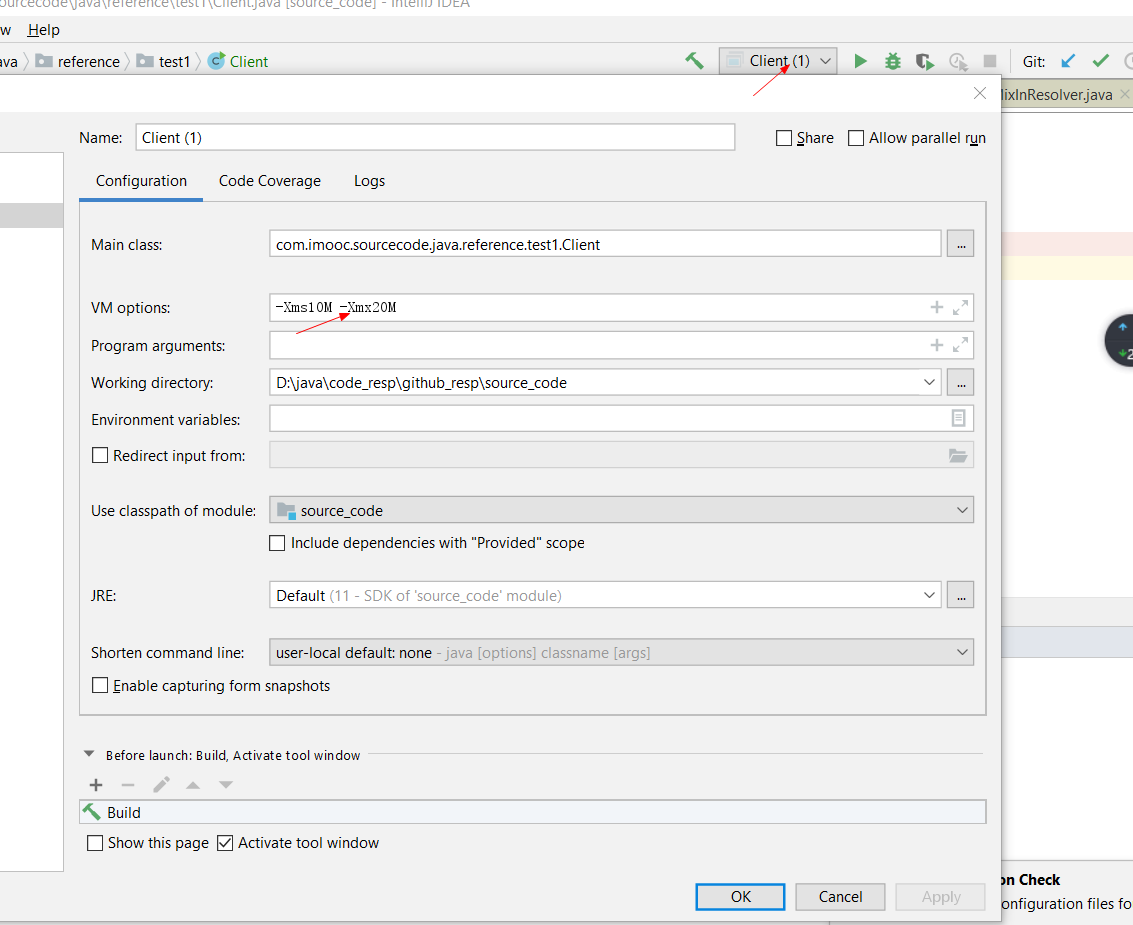介绍
java中的引用有4种类型:强引用(Strong Reference),软引用(Soft Reference),弱引用(Weak Reference),虚引用(Phantom Reference),强度依次减弱。
前置准备
配置JVM参数,-Xms10M -Xmx20M,初始内存10M,最大内存20M,以IDEA为例

强引用
java默认声明的就是强引用,只要强引用还存在,被引用的对象就不会被回收,内存不足时,JVM会直接抛出OutOfMemoryError
public class Client {
public static void main(String[] args) {
byte[] bytes = new byte[10 * 1024 * 1024];
System.out.println(bytes);
}
}
我们申请10M的内存空间,可以正常运行。
public class Client {
public static void main(String[] args) {
byte[] bytes = new byte[20 * 1024 * 1024];
System.out.println(bytes);
}
}
申请20M,就会抛出错误
Exception in thread "main" java.lang.OutOfMemoryError: Java heap space
软引用
在内存充足的时候,软引用不会被回收,内存不足,JVM即将抛出OOM时,软引用就会被回收。这种特性可以用来实现缓存技术。
public class Client {
public static void main(String[] args) {
List<byte[]> bytes = new ArrayList<>();
for (int i = 0; i < 5; i++) {
bytes.add(new byte[10 * 1024 * 1024]);
}
for (byte[] aByte : bytes) {
System.out.println(aByte);
}
}
}
一共申请了50M内存,抛出错误
Exception in thread "main" java.lang.OutOfMemoryError: Java heap space
public class Client2 {
public static void main(String[] args) {
List<SoftReference<byte[]>> bytes = new ArrayList<>();
for (int i = 0; i < 5; i++) {
bytes.add(new SoftReference<>(new byte[10 * 1024 * 1024]));
}
for (SoftReference<byte[]> reference : bytes) {
System.out.println(reference.get());
}
}
}
使用SoftReference类创建软引用,执行结果为
null
null
null
null
[B@3c09711b
这样就说明了在内存不足的情况下,软引用会被自动回收。上面的情况是软引用所指向的对象已经没有强引用了,如果还有强引用,那么软引用不会被回收
public class Client2 {
public static void main(String[] args) {
List<SoftReference<byte[]>> softReferences = new ArrayList<>();
List<byte[]> bytes = new ArrayList<>();
for (int i = 0; i < 5; i++) {
byte[] arr = new byte[10 * 1024 * 1024];
bytes.add(arr);
softReferences.add(new SoftReference<>(arr));
}
for (SoftReference<byte[]> reference : softReferences) {
System.out.println(reference.get());
}
}
}
还是会抛出OOM
弱引用
不管内存是否充足,只要JVM开始垃圾回收,弱引用所指向的对象就会被回收。
public class Client2 {
public static void main(String[] args) {
List<SoftReference<byte[]>> softReferences = new ArrayList<>();
for (int i = 0; i < 5; i++) {
byte[] arr = new byte[10 * 1024 * 1024];
softReferences.add(new SoftReference<>(arr));
}
System.gc();
for (SoftReference<byte[]> reference : softReferences) {
System.out.println(reference.get());
}
}
}
输出结果为
null
null
null
null
[B@3c09711b
对比软引用,我们看一下弱引用
public class Client {
public static void main(String[] args) {
List<WeakReference<byte[]>> softReferences = new ArrayList<>();
for (int i = 0; i < 5; i++) {
byte[] arr = new byte[10 * 1024 * 1024];
softReferences.add(new WeakReference<>(arr));
}
System.gc();
for (WeakReference<byte[]> reference : softReferences) {
System.out.println(reference.get());
}
}
}
输出结果为
null
null
null
null
null
对象全都被垃圾回收了。
虚引用
虚引用是最弱的一种引用关系,相当于无引用,必须与引用队列一起使用
public class Client {
public static void main(String[] args) {
ReferenceQueue<byte[]> referenceQueue = new ReferenceQueue<>();
PhantomReference<byte[]> phantomReference = new PhantomReference<byte[]>(
new byte[10 * 1024 * 1024], referenceQueue);
System.gc();
System.out.println(referenceQueue.poll() == phantomReference);
}
}
垃圾回收之后,虚引用将被放入引用队列中。